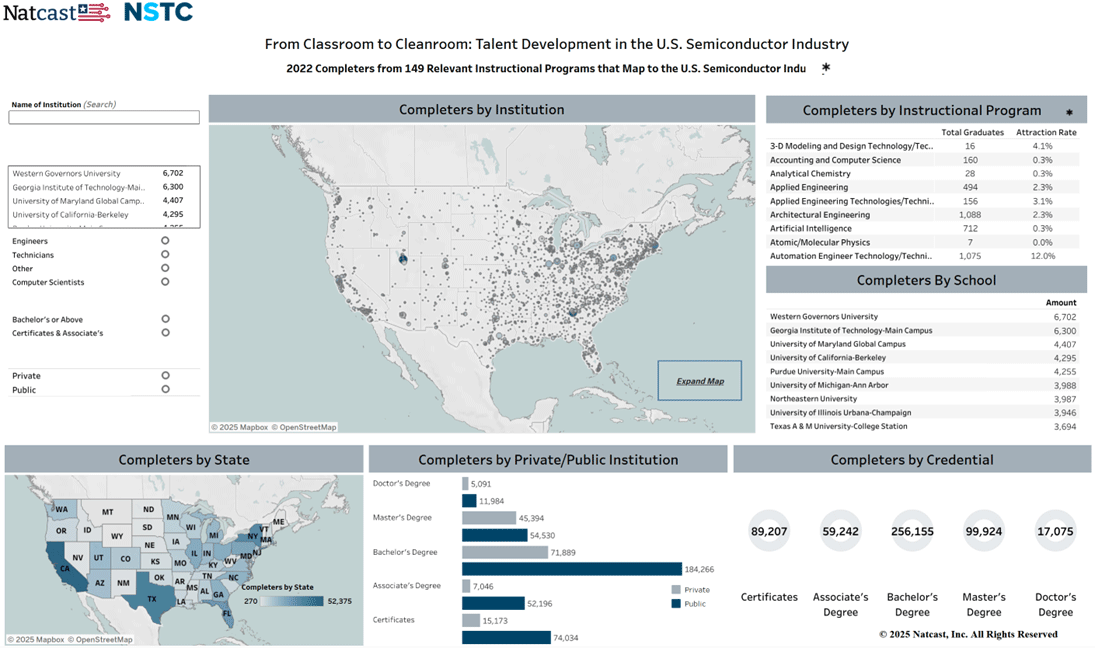Introduction
The U.S. is projected to triple its semiconductor manufacturing capacity and increase its share of global manufacturing capacity from 10% in 2024 to 14% in 2032. As part of that expansion, the U.S. is projected to produce 28% of the global supply of advanced logic chips by 2032, compared to 0% in 2022.[1] This growth in domestic manufacturing will be driven by substantial investments in new semiconductor fabrication facilities and supply chain enhancements. To sustain this growth, there will need to be corresponding growth in the pool of semiconductor talent at every level — from technicians to scientists holding advanced degrees. Recent industry estimates, however, forecast a need for an additional 238,000 semiconductor workers by 2030 but also project that we will fall short of this goal by 67,000 workers[2].
Closing this talent gap is one of three shared and strategic priorities of the National Semiconductor Technology Center (NSTC), established through the bipartisan passage of the CHIPS and Science Act in 2022[3]. The NSTC’s Workforce Center of Excellence (WCoE), which was launched by Natcast and the U.S. Department of Commerce in the fall of 2024, supported by an anticipated investment of $250 million from the Department, aims to fill workforce gaps in the U.S. chip design and manufacturing industry through collaborative and innovative approaches. The mission of the NSTC WCoE is to develop a strong U.S. semiconductor workforce development ecosystem that seamlessly aligns with the rapidly evolving demands of industry, today and into the future. Fulfilling this mission requires a multipronged strategy to accelerate workforce readiness across the nation. To address the challenge, we are focused on three critical priorities:
- Increasing enrollments in programs relevant to the industry (whether by expanding existing program capacity or supporting the launch of new programs);
- Improving completion rates for effective programs; and
- Increasing the rate at which industry attracts trained individuals.
Establishing a Baseline
An essential first step is to build a clear understanding of the talent development landscape as of 2022, creating an inventory of existing resources and a baseline for evaluating the impact of WCoE efforts. The NSTC Workforce Center of Excellence’s first data tool to support these efforts is an interactive dashboard focused on the flow of talent from postsecondary institutions to roles in the semiconductor industry as of 2022.
The dashboard, titled “From Classroom to Cleanroom: Talent Development in the U.S. Semiconductor Industry,” includes 2022 completion data from 149 industry-aligned programs offered by Title IV higher education institutions[4]. By looking at the number of people working in a given occupation in semiconductors vs the number in the larger labor market, we are able create an “industry attraction rate,” which helps us understand the degree to which graduates of semiconductor relevant programs may be entering into semiconductor industry roles.
How to Use the Dashboard
The dashboard can be filtered by credential level, instructional program, location, institution, and private/public institution type. The programs focus on three primary roles critical to semiconductor manufacturing and leadership: Computer Scientists, Engineers, and Technicians. Click on a field to filter to a desired selection, click again to deselect.
The dashboard can answer questions such as:
- What were the top five engineering PhD-producing schools?
- Which institution produced the most Electromechanical and Electromechanical Engineering Technicians at associate degree level?
- In which states were most of the private institution certificate-level programs concentrated?
What’s Next?
This work represents a first step. There are also other avenues of exploration that we will consider going forward. For example, subject to the continued availability of data, we envision:
- Providing updated data capturing this information in years following 2022;
- Creating a trend explorer that will look at how key measures are changing over time, overall and by program; and
- Expanding the data to include other high value measures, such as enrollments or completion rates.
About the Data
The 149 academic programs sourced for this dashboard were identified by mapping the industry roles referenced in the Semiconductor Research Consortium (SRC) Microelectronics and Advanced Packaging Roadmap to the Bureau of Labor Statistics Standard Occupation Classification System (SOC) and focusing on North American Industry Classification System (NAICS) code 334400 (“Semiconductor and Other Electronic Component Manufacturing”). Also of note is that the effects of COVID-19 beginning in the 2020 spring semester may still impact the data due to reduced enrollment[5] and disrupted academic progress during the period studied[6]. Future longitudinal studies incorporating more recent data will be better placed to identify trends in the 149 instructional programs.
If you have questions or would like to learn more about the dashboard and additional ways to engage with the NSTC or the NSTC Workforce Center of Excellence, contact us at [email protected]. Responses to frequently asked questions are published below and will be updated periodically.
[1] Varadarajan, R. et al. (May 2024). Emerging Resilience in the Semiconductor Supply Chain. Boston Consulting Group & Semiconductor Industry Association.
[2] Semiconductor Industry Association & Oxford Economics. (July 2023). Chipping Away: Assessing and Addressing the Labor Market Gap Facing the U.S. Semiconductor Industry. Semiconductor Industry Association.
[3] The Passage of the CHIPS and Science Act of 2022 – United States Department of State
[4] Higher education institutions receiving Title IV federal financial aid are required to submit a variety of data on their program offerings (such as data on program completions) to the Integrated Postsecondary Education Data System (IPEDS) operated by the National Center for Education Statistics. This data is then made available to support students, families, policymakers, researchers, and others navigating or operating in the postsecondary education space.
[5] Trapani, J & Hale, K. (2022). COVID-19 and Higher Education. In Higher Education in Science and Engineering. Science & Engineering Indicators 2022.(ED619278)
[6] Howell, J. et al. (2022). College Enrollment and Retention in the Era of Covid: Fall 2021Update on Continued Pandemic Impacts. College Board.
